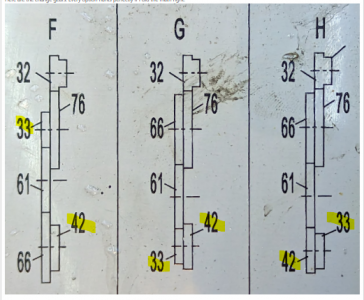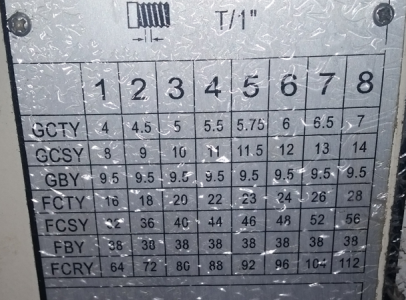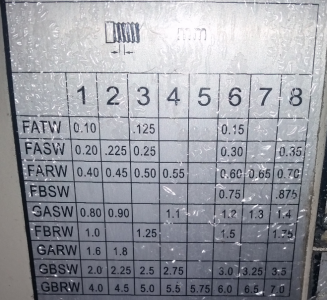About perfection: I don't think two gears have to mesh perfectly to work fine for a long time. As a matter of fact I doubt that perfect mesh is normally obtained on a banjo setup. I've eyeball ground cutters for a flycutting type setup that produce gears that seem to run fine. Using a softer metal for the replacement gear minimizes wear damage on the original that it meshes with. They will "wear-in" to an even better fit.
-
Welcome back Guest! Did you know you can mentor other members here at H-M? If not, please check out our Relaunch of Hobby Machinist Mentoring Program!
You are using an out of date browser. It may not display this or other websites correctly.
You should upgrade or use an alternative browser.
You should upgrade or use an alternative browser.
Cutting an 11-tooth gear
- Thread starter mcdanlj
- Start date
- Joined
- Apr 23, 2018
- Messages
- 6,533
I would not expect the QCTP to hunt perfectly unless it was built around idler gears. A 33/66 is 1:2 with a fixed repeating pattern, but 33/prime/66 hunts, albeit with a direction change (this prime should not be 11 because in this case the gears are multiples of the prime).
I wouldn't worry about it for threading, but for feeds, I'd want some hunt because that's the most used gearing.
To generate thread pitches, common ratios like 1.5:1, 2:1, and 2.5:1 are necessary. So while hunting is a rule, it's not necessarily a principle that must be adhered to. More of a best practice.
I wouldn't worry about it for threading, but for feeds, I'd want some hunt because that's the most used gearing.
To generate thread pitches, common ratios like 1.5:1, 2:1, and 2.5:1 are necessary. So while hunting is a rule, it's not necessarily a principle that must be adhered to. More of a best practice.
Now that I know that I have more mechanical advantage than I need, I can back off and try relatively prime gears that truly hunt. A 19-tooth gear would hunt perfectly against the 66-tooth gear, and a 17-tooth gear would hunt against 76-tooth gear if I need more mechanical advantage. I can test any gear easily in just a few minutes by 3d printing it, and when I know what combination I want, I can cut the final gear out of brass, bronze, or even just POM.
- Joined
- Nov 23, 2014
- Messages
- 2,606
Thanks for going through all of the work! I suspect our G0709's use the 42/33 gears as the universal gear box "translator" between English and Metric threading (ratio is 1.2727). I was curious when I bought mine years ago how they accomplished the switch-over with the flick of a knob. I didn't see any 127/100 gears in the box; figured the 42/33 must be it as the error is only about 0.2%.I've learned a few things:
Here are the change gears. Every option hunts perfectly if I did the math right.
- I now understand why the idler gear in my change gear set has 61 teeth; it hunts perfectly with the other gears that it engages with.
- There are gear pairs in my quick change gearbox that don't hunt much. In particular, the R and T settings select 1:2 or 1:2 ratio gear pairs, and the A setting has a 2:5 ratio.
- I'm currently using a 3D printed 11-tooth gear (from before I asked this) as I'm testing, and it has way more mechanical advantage than I need, so I'm likely to change ratio and not care about cutting an 11-tooth gear after all anyway. I do think that the procedure I outlined here would work to cut an 11-tooth gear with a #8 cutter, though!
Characterizing the G0709 quick change gearbox shows all the gear pairings, some of which don't hunt perfectly, and a few of which hunt very little.
Bruce
Thanks for going through all of the work! I suspect our G0709's use the 42/33 gears as the universal gear box "translator" between English and Metric threading (ratio is 1.2727).
That's not it, though. The 42-tooth gear is used only in the H configuration, and is clearly part of an approximation of pi because the H configuration is used only for cutting module pitches, MP or DP.
Metric threads t/mm and MP use the W; inch worm and threads use Y, and feed (Z and X axes both, and both measured in inches) use X.
- Joined
- Apr 23, 2018
- Messages
- 6,533
The 42/33 is your 127, which gives you half of 254. 254 is your conversion, 2.54 cm/inch.
There is no 42/33 engagement in any published configuration on my G0709. Not for module pitches, not for cutting metric threads, nor for that matter imperial threads or any feed rate.
I know that 42/33 could be used this way. But on the lathe that @BGHansen and I have, it isn't.
This thread is kind of crossing over with my Characterizing the G0709 quick change gearbox thread...
I know that 42/33 could be used this way. But on the lathe that @BGHansen and I have, it isn't.
This thread is kind of crossing over with my Characterizing the G0709 quick change gearbox thread...
- Joined
- Nov 23, 2014
- Messages
- 2,606
I'm referring to the quadrant gears in the F/G/H settings. However, it's making my head spin as the quadrant gears are the same for both metric and English settings.

The knob settings for 1.0 mm pitch thread is FBRW/1; 26 tpi (pretty close to 1.0 mm pitch) is FCTY/7. Seems like the 42/33 in the quadrant wouldn't be a coincidence for the 1.2727 conversion and something in the B vs. C, R vs. T and/or W vs. Y does the swapping between the systems?
Looking at the threading charts below, English uses "C" (with the exception of 'B' used across the board for 9.5 or 38) while Metric uses "A or B". They both use "R/S/T", so nothing there doing a conversion. "W" for Metric and "Y" for English are unique; gotta be something in there plus the 42/33 in the quadrant?
I'm glad they provide the charts! Too many gears meshing together for me to comprehend! I'll reread your ratios previously presented; thanks again for digging into it!
Bruce
p.s. What did you do to seal up your gear box? New gasket from Grizzly? I'm leaning toward a cheesy attempt at sealing the cover to the box externally with Flex Seal tape. Mine drips out of the very bottom, hoping that cleaning the surfaces, then an external wrap of tape might do it. It's not under a lot of pressure, so maybe this would work? However, in my experience the cheesy solutions end up being a waste of time.



The knob settings for 1.0 mm pitch thread is FBRW/1; 26 tpi (pretty close to 1.0 mm pitch) is FCTY/7. Seems like the 42/33 in the quadrant wouldn't be a coincidence for the 1.2727 conversion and something in the B vs. C, R vs. T and/or W vs. Y does the swapping between the systems?
Looking at the threading charts below, English uses "C" (with the exception of 'B' used across the board for 9.5 or 38) while Metric uses "A or B". They both use "R/S/T", so nothing there doing a conversion. "W" for Metric and "Y" for English are unique; gotta be something in there plus the 42/33 in the quadrant?
I'm glad they provide the charts! Too many gears meshing together for me to comprehend! I'll reread your ratios previously presented; thanks again for digging into it!
Bruce
p.s. What did you do to seal up your gear box? New gasket from Grizzly? I'm leaning toward a cheesy attempt at sealing the cover to the box externally with Flex Seal tape. Mine drips out of the very bottom, hoping that cleaning the surfaces, then an external wrap of tape might do it. It's not under a lot of pressure, so maybe this would work? However, in my experience the cheesy solutions end up being a waste of time.


The knob settings for 1.0 mm pitch thread is FBRW/1; 26 tpi (pretty close to 1.0 mm pitch) is FCTY/7. Seems like the 42/33 in the quadrant wouldn't be a coincidence for the 1.2727 conversion and something in the B vs. C, R vs. T and/or W vs. Y does the swapping between the systems?
The 42 is not driven in the F configuration. Nothing touches those 42 teeth.
F: 32:76 33:66
The 61-tooth in the middle is just an idler, and the 42-tooth gear engages with nothing.
That's a red herring.
But again, this is probably the wrong thread for that.
- Joined
- Jun 7, 2013
- Messages
- 10,089
Fact is that lathes have not worried over hunting ratios in their feed/threading trains for hundreds of years, and it has not much mattered.

